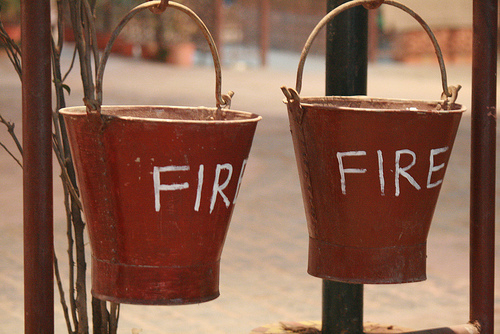Managing Fire Accidents Part II: Are You Ready?

All disasters–whether floods, earthquakes, cyclones, droughts or fire–inevitably cause upheavals not only in the physical but also in the social and economic context where they occur. In our last post, we discussed about fire hazard and steps you can take to prevent the occurrence of a fire disaster. Fire has very special characteristics if one considers the particularities of the causative agent and the type of damage it produces to living beings. Also, when fire comes into contact with objects and materials it burns or destroys them in a relatively short time.Thus, there is a greater need to not just prevent fires in urban and densely packed settings but also be ready in the event of a fire disaster. Of course, the safest thing to avoid harms caused by fire would be to always be out in the open and keep all your belonging in a self storage somewhere away from your home. But that is far from doable all the time.
We therefore share with you some action points one needs to be aware of in order to be ready to tackle with a fire crisis. It needs to be noted here that the impact of fire on a living organism can be lethal within a few seconds. Fire determines a pathological condition, the burn, which is considered to be the most complex trauma that can strike the human body. Burn disaster management must, besides prevention, should therefore be directed towards planning and application of measures necessary to mitigate the damage caused to humans, to prevent its aggravation, and to promote healing. At the same time, It is now established that a small flame can get completely out of control in seconds and turn into a major fire. In minutes a home or a workplace can be engulfed in flames giving a very short ‘window’ period to escape.
The recent fire in the North Block in New Delhi district, fire accident in Maharasthra Secretariat and also the Sivakasi cracker factory fire in South India which claimed many innocent lives are glaring examples of how we need to be much more fire ready than we presently are. All zones with high probability of fire events should be enlisted on an urgent basis and case-by-case basis preparedness plans should be made and/or evaluated in these zones. The Fire-disaster related preparedness assessment must include:
- rapid evaluation of the extent of the disaster
- use of self storage fire extinguisher devices
- specific and rapid health assistance response on site
- assessment of the capacity of local specialized structures to receive burn victims
- selective evacuation of casualties from the disaster area.
Fire is Deadly. Fire produces heat, smoke and toxic gases. Smoke and toxic gases travel faster than heat hence they kill more people than flames do. Breathing even small amount of smoke and toxic gases can make you drowsy, disoriented and short of breath. The odorless, colorless fumes can lull you into a deep sleep before the flames reach your door. In order to ensure you do not get entrapped in such a situation, here are some quick tips in case you get stuck in a fire event (via firesafetyindia.com):
- Stay calm, don’t panic and don’t run
- Raise alarm and alert everyone in your premises
- Escape first and then call for help
- Use nearest available exit routes
- While leaving the premises, close all doors and windows behind you if possible but must ensure that anybody is left behind and you are safe.
- Use only escapes routes because they are built for the purpose
- Use Staircases. “Do NOT use Lifts’
- If you come to a closed door, use the back of your hand to feel the top of the door, the doorknob and the cracks between the door and door frame to make sure that fire is not on the other side. If it feels hot, use your secondary escape route. Even if the door feels cool, open it carefully. Brace your shoulder against the door and open it slowly. If heat and smoke come in, slam the door and make sure it is surely closed, then use your alternate escape route.
- If you are trapped in smoke logged area, lay down and keep your nose close to floor and crawl towards an exit point
- If you become trapped in your room closes the door and blocks any gaps which might let smoke or fumes through. Shout from the window to attract the attention of rescue team as well as others
Remember, it is better to be aware and safe, than to be sorry.
Image by jeporrier over Creative Commons




Relying on your scanner, you might have to power it on, or it may perhaps self-activate.
The OBD 2007 computer software interface is extremely very well arranged.